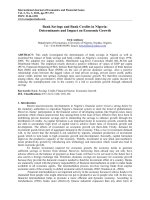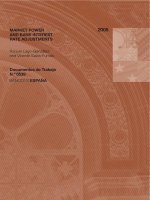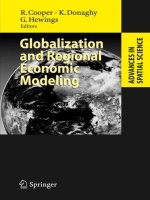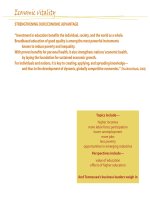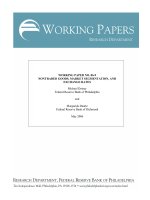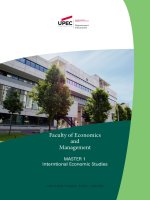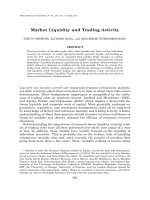Understanding Market Mayhem and Stabilizing our Economic Future_5 doc
Bạn đang xem bản rút gọn của tài liệu. Xem và tải ngay bản đầy đủ của tài liệu tại đây (281.97 KB, 28 trang )
DEAR DR. FREUD . . .
Thanks, Doc, for seeing me on such short notice. I guess I should confess at
the outset that I’ve never done this before; Italians traditionally go to con-
fession. But I figure if Tony Soprano can whine about the emotional stress
he feels as he blows people’s brains out, then I can bend your ear about
anxieties I have been feeling as a Wall Street “talking head.”
For nearly 20 years, Doc, I figured I had the best job in the world. I get paid
for staying on top of what’s happening around the globe, and for declar-
ing, once in a while, that I see important change on the horizon. It’s hard to
describe exactly how I come by my views. I read a great deal, I pore over
data, and I talk, nearly nonstop, with clients about the world around us.
Being highly compensated for staying well-informed and venturing forth
with opinions, as far as I was concerned, was the best-of-all-possible jobs.
Until now! You see, Doc, all of a sudden I’m trapped by the images I see
when I gaze into my crystal ball. The best part of my job is when the light
bulb goes off above my head, and it dawns on me that the world is about
to change. That’s when I weave together a story about how tomorrow will
be different, and I speculate about how investors can position themselves
for what’s on the horizon. Whether standing at a podium, sitting in a con-
ference room, or cradling a telephone, I’m invigorated as my logic and
enthusiasm capture my colleagues’attention. And if, over the ensuing quar-
ters, my guesswork proves prescient, then I get the exhilaration of having
been right about the changes that arrived on the economic scene.
But, Doc, what do you do if you don’t like what you see? Worse, what do
you do if your image of the future is retrograde, old school, and ugly, and
it stands in stark contrast to an overwhelmingly wonderful brave-new-
world-of-the-here-and-now?
What do I do, Doc, if my vision casts me in the role of Cassandra? There I
am, at the podium, weaving my web, waving my wand, working my magic
in an effort to win the audience over. But, who in their right mind would
want to convince a group of his peers that things are not really that differ-
ent, and that old fears are indeed well-founded?
And, Doc, I wish. Oh, how I wish I could believe. Life would be wonderful
for me now if my crystal ball conjured up a picture of enduring perfection.
118 • T
HE
C
OST OF
C
APITALISM
Let’s face it, Doc, it may be me that lacks the vision. I just didn’t have the
foresight to quit college, start a firm, and earn $250 million before I was 30.
I got a Ph.D., taught at MIT, worked in Washington and on Wall Street, and,
at almost 50, I’ve discovered that I’ve been in the slow lane for all these
years! So, who knows, maybe the dark color of my crystal ball is nothing
more than the reflected hue of sour grapes.
Maybe a short list of soaring shares and a surge in margin debt and a gri-
macing Fed Chairman are all irrelevant. Maybe the old rules are for people
like me, old fools. . . .
But, Doc. Doc, when I wake in the middle of the night, my nightmare is
always the same. It’s Lucy, Doc. And, I’m Charlie Brown. It’s Lucy. She’s hold-
ing the football. She’s promised everyone that this time she won’t pull it
away. And, she told the truth, Doc, to everyone else.
She purrs that I’m the last to believe that in the new world, things can be
counted on to be better than expected. Come on, she says, don’t be the
only one who hasn’t shed his anxieties.
She wants me, Doc. Me. As the Charlie Brown of Wall Street, she wants me
to conquer my fear. She wants me to run, pell-mell, toward the football she
balances below her finger. She wants me, in full stride to unabashedly kick
the football through the uprights and join the crowd of believers. And I
hem, Doc, and I haw. And, I twist and turn. But the crowd grows more rest-
less, and her gaze is enticing, and I want oh so much to be one with the
happy campers, back amid the bullish who believe. And, so I go, I run, I do
it, full speed, no fear, it’s only right, why be a doubting Thomas. And, so I
swing my leg, full-out, and almost see the ball splitting the uprights as it
soars in the air.
But, no. My leg swings harmlessly through empty space. Lucy cackles, foot-
ball in hand. The crowd has disappeared. She’s laughing as I lay on my
behind.
And there I lay, and then I mumble, Doc, I mumble. It’s always the same,
I just mumble, quietly mumble, “But, Lucy, you promised that it would be
different this time.”
The Brave-New-World Boom Goes Bust: The 1990s Technology Bubble • 119
This page intentionally left blank
Part III
EMERGING REALITIES:
2007-2008
This page intentionally left blank
• 123 •
Chapter 10
GREENSPAN’S CONUNDRUM
FOSTERS THE HOUSING
BUBBLE
You got to be careful if you don’t know where you’re going, because
you might not get there.
—Yogi Berra
M
ost commentators argue that the seeds of the 2008 upheaval are
to be found in the U.S. housing market. I certainly agree that
the immediate causes of the crisis were made in the U.S.A. Wall Street
“innovation” delivered us new ways to borrow in order to buy a home,
and these mortgages, we now know, had serious flaws. Mortgage orig-
inators collapsed borrowing standards, leaving the housing financing
market with absolutely no margin of safety. The entire architecture of
mortgage finance, it’s now perfectly clear, depended upon an unend-
ing rise for home prices. And the long-standing Greenspan refusal to
react to asset prices kept money easy and inflated the game, worsen-
ing both the bubble and the bust.
But access to easy mortgage money in the United States and many
other developed world housing markets began in the late 1990s. Low
interest rates throughout much of the developed world were an impor-
tant part of the rescue operation for Asia, following the currency crises
and deep recessions that gripped many Pacific Basin nations. In the
pages that follow, therefore, we start not in 2005 but in 1998.
The 1998 Ease: Greenspan Saves the World?
Monetary policy in the late 1990s was just too easy. It nurtured the
technology share price bubble into early 2000. The collapse for tech-
nology stocks, through much of 2002, in turn required a major dose
of easy money. Clearly, the big ease in 2001-2003 played a key role in
creating the next bubble—this time in the U.S. housing market.
But the world outside of the United States in the late 1990s was
marching to a very different drum. As we detailed in Chapter 8, crisis
took hold in many emerging Asian economies. Their distress infected
U.S. financial markets. The Fed chose to ease interest rates in the fall
of 1998, in direct response to the Long-Term Capital Management
crisis. But the precipitating event that resulted in the LTCM panic
was Russia’s default. Clearly, U.S. monetary policy was responding to
U.S. concerns, but global dynamics were key drivers.
Moreover, the green light that allowed Fed officials to stay easy in
the late 1990s was low inflation. Careful analysis, today, reveals that it
was the rest-of-world bust, not the brave-new-world boom, that
explained the implausibly good inflation news of the period. Recall
that from mid-1996 through mid-1999 the U.S. economy boomed, the
unemployment rate fell to lows not seen since the early 1960s, and
U.S. inflation fell. New economy enthusiasts attributed the good news
124 • T
HE
C
OST OF
C
APITALISM
to the powers of the computer and the cell phone, and envisioned an
extended period of serenity.
A more sober look at the data supports a less inspiring explanation.
Asia’s collapse in 1997-1998 drove the dollar price of almost anything
that traveled on a boat sharply lower. What happened? Deep Asian
recessions cut the global demand for raw materials and for oil. Plung-
ing Asian currencies drove the dollar prices of consumer manufac-
tured goods down.
From the U.S. Fed’s perspective, however, the whys and the where-
fores were not important. Inflation was low, and share prices were not
on their radar screen. Fed policy stayed easy amidst the U.S. economic
boom.
As far as Asia was concerned, the easy-money-stoked boom for U.S.
housing and consumer spending was music to their ears. In 1999, at
a Congressional hearing on the U.S. trade deficit, I put it this way:
The U.S. Fed and the U.S. consumer deserve medals for their
performance over the 1998-1999 period. Asia’s collapse could
well have triggered a global deflationary bust, but for the timely
and aggressive ease of the U.S. Fed last year. . . .
Going forward, the newly emerging reality of rest-of-world
recovery ends the need for booming U.S. spending. Moreover,
the U.S. would be wise to steer a course aimed at slowing deficit
growth, given the large and rapidly growing U.S. need for for-
eign capital inflows to finance this imbalance.
1
As it turned out, low inflation, like almost everything else in the
world at that time, was mostly made in Asia. Combine low inflation
with easy Fed policy and falling Asian access to investment funds and
Greenspan’s Conundrum Fosters the Housing Bubble • 125
we have an explanation for an unusual circumstance: very low mort-
gage rates in a booming U.S. economy. Much of the strength for hous-
ing and consumer spending in 1997-2000 was a consequence of the
bust that enveloped emerging Asia.
The 2001 Brave-New-World Bust
Fails to Lay a Glove on Housing
As I noted above, it was unusual for mortgage rates to remain low late
in an economic expansion. In the boom and bust cycles of the 1960s
and 1970s, housing booms occurred in the first few years of a recov-
ery. As the expansion ages, interest rates tend to rise. A spike for infla-
tion and interest rates is the catalyst for recession. And housing
investment, without exception, plunges (Figure 10.1).
126 • T
HE
C
OST OF
C
APITALISM
82818079787776757473727170696867666564636261
2500
2000
1500
1000
500
In 000s, SAAR, 3-Month Moving Average
Housing Activity Plunged
in Every Recession, 1961-1982
New Privately Owned Housing Units Started
Figure 10.1
This did not occur, however, in the recession of 2001.
A short-lived bout of aggressive Fed tightening in early 2000
elicited a modest jump for long-term interest rates and a six-month
pullback for housing starts. By late 2000 it became clear to the world
that plunging technology share prices were ending the investment-
led boom of the 1990s. Aggressive interest rate ease by the Fed, start-
ing in the first week of 2001, encouraged a falling interest rate regime
that lasted for nearly three years. By the end of that easing process,
interest rates—including and especially mortgage rates—had fallen
to levels not seen in a generation. Housing has always been the most
interest-sensitive sector of the U.S. economy. Over the 2001-2003
period, housing failed to fall much and then began to rise with pow-
erful momentum. The U.S. housing market simply skipped the reces-
sion of 2001(Figure 10.2).
Greenspan’s Conundrum Fosters the Housing Bubble • 127
0201009998979695949392919089888786
2000
1800
1600
1400
1200
1000
800
In 000s, SAAR, 3-Month Moving Average
Housing Activity Ignored the 2001 Recession
New Privately Owned Housing Units Started
Figure 10.2
Greenspan’s Conundrum:The Fed Tightens
and Asia Keeps Market Rates Low
The collapse for technology investment and the quick recession that
took hold explain the persistence of low mortgage rates and the rela-
tively healthy performance for housing in the 2001-2003 period. The
housing boom, however, was just getting started.
The early years of the expansion ushered in the concept of the
China price. In the late 1990s low U.S. inflation reflected the collapse
of many Asian economies. The fantastic rise in exports from China to
the United States, 2002-2004, delivered an avalanche of super-low-
priced consumer goods. Core consumer goods prices in the United
States actually fell sharply in 2003 for the first time on record (see Fig-
ure 10.3). Fed policy makers, blinded by low core inflation, kept inter-
est rates extremely low throughout 2003. Only after it was clear that
the Bush tax cuts had put the U.S. economy into high gear did Fed
policy makers begin to raise interest rates.
128 • T
HE
C
OST OF
C
APITALISM
050301999795939189878583817977757371696765636159
12
10
8
6
4
2
0
–2
–4
Year over Year % Change, 12-Month Moving Average
The China Price: U.S. Consumer Goods
Prices in Sharp Retreat, 2002-2004
Consumer Price Index, Commodities Less Food and Energy Commodities
Figure 10.3
The Fed began lifting the Fed funds rate in April of 2004. From a
low of 1 percent, it raised Fed funds by 25 basis points. The Fed soon
made it clear that it was its intention to slowly raise the Fed funds rate.
Given the low inflation backdrop, it saw no need to quickly remove
the stimulus that low interest rates provide.
Much of this book is concerned with the logical flaw that led the
Fed to raise rates at only a glacial pace. As I have been emphasizing,
by narrowly defining excess, Fed policy makers ignored the growing
housing bubble with its clear potential to wreak havoc somewhere
down the road. As a consequence, the Fed started tightening too late,
and it tightened much too slowly.
But the boom in housing benefited from more than a timid Fed.
As the chart in Figure 10.4 reveals, for over a year, Fed-engineered
increases in short-term interest rates had nearly no effect on the level
Greenspan’s Conundrum Fosters the Housing Bubble • 129
05040302010099
10
8
6
4
2
0
Rate (%)
Greenspan’s Conundrum: The Fed Lifts the Funds Rate,
but Long-Term Interest Rates Completely Ignore the Rise
30-Year Jumbo Mortgage Rates vs. Federal Funds Target Rate
30-Year Jumbo Rates
Fed Funds Target Rate
Figure 10.4
of long-term interest rates—including and especially fixed rate mort-
gages. In May 2004, on the eve of the Fed’s first tightening move, con-
ventional fixed rate mortgages were available at 5.9 percent. In
December 2005, after the Fed raised short-term rates by over 3 per-
centage points, fixed rate mortgages were still available at 6.3 percent!
Greenspan was bemused by the failure of long rates to rise. He went
so far as to name the phenomenon. He called it a “conundrum.”
It certainly was puzzling to me. I spent 2004 and 2005 incorrectly
predicting that stepwise Fed tightening would lift long-term interest
rates and temper the housing boom. Instead, steady increases in the
Fed funds rate failed to tighten credit availability, and the housing
boom built momentum.
Greenspan’s soon-to-be successor, Ben Bernanke, offered up an
explanation for the conundrum. A global savings glut, largely building
up in Asia, was lowering real borrowing costs for investment projects
in developed world economies. In other words, free-flowing interna-
tional capital markets were lowering U.S. homeowner borrowing costs,
because investment opportunities in Asian nations were limited.
Other observers, including me, came to believe a different story.
China and a handful of other Asian countries were intent on keeping
their currencies pegged to the U.S. dollar. To do so, they needed to
buy U.S. bonds. And they ended up buying trillions of dollars’ worth
of U.S. Treasury bonds and mortgage backed bonds. In effect, Asian
central banks were thwarting the Fed’s effort to raise rates. As I put it,
in a research report in 2006:
Who Is in Charge of U.S. Monetary Policy, Hu Indeed!
2
So Greenspan called it a conundrum. Bernanke explained it in
terms of global savings. I saw it as easy money emanating from the
130 • T
HE
C
OST OF
C
APITALISM
Asian central banks. Any way you sliced it, however, U.S. long-term
interest rates were not responding to Fed policy actions. Thus, just as
the late 1990s U.S. boom was in part a reaction to the Asian bust, the
2004-2005 housing boom in part reflected the rest of the world’s influ-
ence on U.S. interest rates.
Does this absolve Greenspan/Bernanke from responsibility? No.
The Fed was making two mistakes in the mid-2000s. It failed to focus
on the housing bubble. And it ignored the absence of any tightening
of credit in 2004-2005, comfortable in the knowledge that inflation
was low and it was raising its target rate.
Fed miscalculation alongside Asian money flows kept U.S. mort-
gage rates low throughout much of the 1998-2005 period. And the
extended good times for people in businesses tied to housing or hous-
ing finance created false confidences, financial innovations, eupho-
ria, and ultimately fraud. In short, we witnessed the creation of a
spectacular asset bubble.
The Key to the Kingdom: House Prices
Never Fall!
As we saw with the strategy employed by Hanna in Chapter 3, buying
a McMansion with next to no money down and with a small monthly
paycheck can succeed—if the value of the property rises. Companies
in the business of providing mortgage money to buyers like Hanna
embraced the same basic model, as they created easier and easier ways
for potential home buyers to get credit.
Why would any lenders, in their right minds, give money to buyers
who put no money down and provided no paperwork on their monthly
incomes? The lenders calculated that the losses from default would
Greenspan’s Conundrum Fosters the Housing Bubble • 131
be limited, since they would end up owning the houses. Since house
prices always go up, the mortgage holders would receive assets whose
values were in excess of the monies loaned. Deadbeat borrowers
notwithstanding, there really was no problem. True enough, the
national median home price never fell from 1966 through 2002. And
powerful mathematical models inputted that “truth.”
The fact that many mortgage companies that issued credit to home
buyers were not in the business of holding the mortgages created
moral hazard. The mortgage originators collected fees and passed the
mortgages to Wall Street firms. Wall Street sliced and diced mortgages
and placed mortgage products—collateralized mortgage obligations—
into the hands of institutional investors in the United States and
around the world. Rating agencies, mesmerized by the math and
oblivious to the need for ever higher home prices, gave triple A rat-
ings to highly dubious mortgages. From afar, it was easy to buy the
product with no real understanding of what you had.
Low Market Interest Rates + Creative
Finance = Surging Home Prices
Wall Street convinced itself that mortgage products were safe because
home prices did not fall. Home buyers, employing the same logic,
embraced risky financing strategies in order to buy more house than
they otherwise could. Hanna’s approach to mortgage finance was tak-
ing hold.
For nearly five years this mutual admiration society between bor-
rowers and lenders fed on itself. More to the point, it created a posi-
tive feedback loop. The bank is aggressively looking to lend money,
thereby increasing the number of potential home buyers. This
132 • T
HE
C
OST OF
C
APITALISM
increase in demand drives home prices higher. Higher home prices
make it easy for recent home buyers to refinance and take out extra
cash to cover their mortgage payments. Foreclosures, as a conse-
quence, remain very low. Mortgage providers point to low default lev-
els as confirmation that their models are on track. Mortgage rocket
scientists invent products with even easier initial terms. This further
expands the pool of available home buyers. Home price gains accel-
erate. And the upward spiral is renewed.
From mid-2001 through mid-2005 this positive feedback loop took
home prices to extraordinary levels. Most significant, the climb for
home prices wildly outstripped income gains, climbing by nearly
10 percent per year, on average, in a time when incomes were grow-
ing at 4 percent per year. As the chart in Figure 10.5 shows, from mid-
2001 through mid-2005 the median home price in the United States
went from a bit less than 6 times the average person’s available income
Greenspan’s Conundrum Fosters the Housing Bubble • 133
060504030201009998979695949392919089888786
8.0
7.5
7.0
6.5
6.0
5.5
5.0
Share (%)
The Climb for House Prices
Outstripped Income Gains
Median Sales Price, Existing Single Family Homes Sold vs. Disposable Personal Income Per Capita
Figure 10.5
to nearly 8 times the income. In California, by early 2005, home prices
were 11 times per capita income. Hanna’s risky approach to mortgage
finance was the only option new home buyers in California could
employ. More to the point, betting that the home price would rise was
the only way a buyer could make the mortgage payments over a mul-
tiyear period.
Surging home prices for existing homeowners, of course, was a
bonanza. Real estate, due to home ownership, remains by far the
biggest asset for most Americans. Rising home prices, therefore, trans-
lated into rising wealth for a great many people. And numerous stud-
ies revealed that in the 2001-2005 period, hundreds of billions of
dollars of that wealth was being tapped into.
In the early 1990s we witnessed a multiyear refinancing boom that
supported strong consumer spending. Homeowners turned in their 10
percent mortgages for 7 percent mortgages. This freed up cash for cur-
rent purchases, given the new lower payments that were put into
place. The refinancing boom of 2002-2005 was different. Interest rates
were relatively steady. Homeowners improved their short-term pur-
chasing power by increasing the size of their loans. They simply used
the cash to finance current purchases. The result was a period in
which consumer spending stayed strong despite the fact that rising
energy and food prices were squeezing household purchasing power.
Tapping into newfound housing wealth made homes into ATMs.
China as the Master of Vendor Finance?
Low mortgage rates, booming housing refinance, and strong consumer
spending defined 2002-2005. Much of the spending was on products
made in China. Incredibly, over the first five years of the new decade,
134 • T
HE
C
OST OF
C
APITALISM
China’s exports to the United States rose from 4 to 11 percent of
nonauto U.S. retail spending. China’s excitement about this export
boom led directly to its strategy for conducting monetary policy. Cen-
tral bank authorities were willing buyers of the U.S. dollar in order to
make sure that there was very little change in the dollar/
Chinese yuan exchange rate.
Accordingly, they bought the U.S. dollars that Chinese manufac-
turers collected for their exports. They bought the dollars that U.S.
multinational corporations spent as they built factories in China. They
bought the dollars U.S. investors funneled into Chinese real estate. In
total, these purchases led to China’s accumulating trillions of dollars’
worth of U.S. Treasuries in a remarkably short period. If we accept the
assertion that China’s bond buying kept mortgage rates low in the
United States, we come to an interesting conclusion. China kept U.S.
long rates low by lending trillions to the United States. Low mortgage
rates allowed Americans to borrow against their homes and use the
proceeds to spend. And, increasingly, they bought products that were
made in China—vendor financing on a trillion-dollar scale!
Emerging Nations Provide Low Interest Rates
to the Developed World
It is instructive to focus on China, America, and housing when think-
ing about the bubble of 2002-2005. But if we look at asset markets and
economies in the rest of the world, it’s clear that similar dynamics were
unfolding. Certainly, China’s exports to Europe soared over the period.
In fact, by late 2006, China exported as much to the European Union
as it did to the United States. China also bought hundreds of billions
of euros’ worth of Continental sovereign bonds. Other emerging
Greenspan’s Conundrum Fosters the Housing Bubble • 135
nations, including Russia, India, and Brazil, were giant buyers of devel-
oped world bonds, contributing to the low long-term interest rate back-
drop that was in place.
An IMF study in 2006 showed that house prices were “well above
fundamental values” in a long list of countries. Ireland, Britain, Aus-
tralia, Norway, France, Sweden, and Spain all had serious house price
inflation excesses. The simple truth was that interest rates were very
easy in much of the developed world. And a housing bubble formed
here, there, and almost everywhere.
The Overarching Euphoria: A Crazy Low Price
for Risk
As the global economy improved in 2004-2005, central bankers in the
United States and in much of the rest of the developed world began
to raise interest rates. As I noted, these efforts were in part thwarted by
enormous bond buying by emerging-economy central banks. We can
see that in the nearly nonexistent rise for long-dated U.S. Treasury bor-
rowing rates. More important, however, corporations actually saw their
borrowing costs fall from late 2003 through late 2005, notwithstand-
ing the Fed’s increase of over 3 percentage points for its target over-
night rate. As the chart in Figure 10.6 reveals, risky company
borrowing costs were falling despite Fed tightening.
To put this in perspective, amidst the carnage of the technology
bust, in 2002, a risky company—a Baa borrower—had to pay 5.5 per-
cent, adjusted for inflation, to borrow. At that time, the federal gov-
ernment’s real borrowing cost was 2.5 percent. The difference, of
course, compensates the lender for the possibility that the company
might go bankrupt. By late 2005 the same company’s real borrowing
136 • T
HE
C
OST OF
C
APITALISM
rate had fallen to 4.25 percent despite the fact that the federal
government was still being charged 2.5 percent. Most important, the
fact that the Fed funds rate had been lifted over the period was irrel-
evant to borrowers in business. Their borrowing costs were lower, and
the global boom was proof positive that they knew full well that it
was so.
In summation, in 2005, despite a boom in housing and the reality
of super low borrowing rates offered up to risky companies, the Fed
and other developed-economy central banks were comfortable with
the backdrop. Ultimately, rising energy prices pushed interest rates up.
The ensuing bust first gripped the United States and then became a
world recession. The dynamics that precipitated the U.S. recession,
the global capital markets crisis, and the worldwide downturn, are the
subject of the next two chapters.
Greenspan’s Conundrum Fosters the Housing Bubble • 137
05040302
6
4
2
0
–2
Yield (%)
Real Borrowing Rates for Risky Companies Fell and
Real Government Bond Yields Held Steady,
as the Real Fed Funds Rate Slowly Rose
Corporate Bond Yield, Baa - Core CPI vs. 10-Year Treasury Note - Core CPI vs. Fed Funds Target Rate - Core CPI
Real Corporate Bond, Baa
Real 10-Year Treasury Note
Real Federal Funds Target Rate
Figure 10.6
This page intentionally left blank
• 139 •
Chapter 11
BERNANKE’S CALAMITY
AND THE ONSET OF
U.S. RECESSION
If . . . we are tempted to assert that money is the drink which
stimulates the system to activity, we must remind ourselves that
there may be several slips between the cup and the lip.
—John Maynard Keynes, The General Theory of Employment,
Interest, and Money, 1936
H
ow did boom become gloom? Risky finance in U.S. real estate
and easy money in general came to an end, a consequence of
capital market and central bank responses to surging energy and food
prices. The last leg up for short-term interest rates and some belated
rise for long-term interest rates finally weighed on the U.S. housing
boom. Once the housing surge began to falter, the explosive positive
feedback loop of 2002-2005 began to work in reverse.
When Fed ease proved as ineffectual as Fed tightening, it became
apparent to those who understood the housing dynamic that a hard land-
ing for housing could not be avoided. This was sure to weigh heavily on
consumer spending and therefore spelled outright recession for the U.S.
economy. The full implications of the hard fall for housing played out
in the collapse of the existing financial economic order—following a
dominolike fall of financial institutions.
Global market mayhem and consequent worldwide recession are
the subjects of the chapter that follows this one.
The Crisis Begins in 2006, as Rising Mortgage
Rates Pop the Housing Bubble
For conventional analysts, falling home prices in 2006 and early 2007
were a sideshow. Booming Asian economies had driven oil and other
raw materials prices sharply higher, lifting worldwide inflation
readings. In the United States, Fed interest rate increases, as of late
2005, were being matched by increases in long-term interest rates.
Ten-year Treasury yields, locked in a tight range centered around 4.25
percent for several years, jumped and were yielding 5.25 percent by
the spring of 2006. The fear among central bankers and in global bond
markets was that unrelenting energy and food price increases might
carry the day and stoke a generalized surge for global inflation.
Suddenly, the seemingly endless period of easy money to finance
home purchases was coming under pressure. From late 2005 through
mid-2006, fixed rate mortgages rose by a full percentage point. The
6 percent fixed rate was now a 7 percent fixed rate. Moreover, the
cumulative rise for the Fed funds rate stood at over 4 percentage points
by mid-2006. Thus, the initial interest rate charged for an adjustable
rate mortgage was up sharply. The final climb for overnight rates had
forced even the most creative mortgage providers to lift their teaser
rates—the cost of money forced them to make the adjustment.
140 • T
HE
C
OST OF
C
APITALISM
Starting in late 2005, home sales began to slow from what had been
an unprecedented pace in 2004-2005. The falloff in demand for
housing gave remaining home buyers some welcome advantage as
they dickered over price. The results were not really surprising. House
prices—after an unprecedented run and amidst faltering demand—
began to fall. But we learned in Chapter 3 that by late 2005 around
half of the newly issued mortgages were designed with Hanna’s view
of the world in mind. More to the point, rocket scientist models
estimating the value of complex mortgage products were, in the end, just
as susceptible to crisis as Hanna was if home prices started retreating.
And by mid-2006 they were doing just that.
Rising house prices, Hanna taught us, allowed the subprime
borrower to earn a capital gain on her house and miraculously be
transformed into a prime borrower. Once house prices stopped rising,
the mortgage market faced an immediate problem. At first it was
confined to subprime borrowers and their lenders. But the dynamic
of falling house prices quickly infected the entire housing industry.
Initially, the defaults were all in risky mortgages. But the wave of
foreclosures that resulted precipitated acceleration on the downside for
house prices. Soon enough it became apparent that no one was safe.
Lower prices apply not just to houses financed with subprime mort-
gages, but to all houses. As a result, all mortgages backed by houses in
areas where prices were falling began to lose value, even those made
to prime borrowers. Wall Street firms found themselves knee deep in
mortgages of questionable value. They were also the providers of credit
to regional firms who were even deeper into mortgages.
In August 2007 the first panic ensued, and the housing crisis
commanded everyone’s attention. A majority of analysts began to
recognize that home prices were destined to fall dramatically. The
Bernanke’s Calamity and the Onset of U.S. Recession • 141
banks holding mortgage products had to radically reduce the values
of these products on their balance sheets. The first in a succession of
crises about the state of mortgage banking led to a wholesale change
in attitudes about risk taking. Stocks fell sharply. Newfound anxieties
about the bankruptcy risks jumped, and company borrowing rates
soared. Not surprisingly, confidence in mortgage products imploded.
Mortgage interest rates jumped to new highs for the cycle, as former
buyers of mortgages backed away. For those who knew where to look,
it was clear that the era of crazy easy finance was now in sharp retreat.
The Crisis Worsens as Central Banks Mistakenly
Fight Inflation
Nonetheless, the U.S. Federal Reserve Board, still with a misguided
fascination with headline price statistics, fought desperately to avoid
lowering interest rates. As late as August 7, 2007, it contended that
inflation was the primary risk that threatened the U.S. economy. Hav-
ing failed to recognize the wild excesses in finance that dominated the
landscape in 2005 and 2006, it symmetrically failed to appreciate the
wild credit tightening taking place in 2007.
Mainstream commentary loudly echoed the Fed’s focus on inflation.
In August 2007, I was asked on CNBC to comment about prospective
Fed policy. I volunteered that I thought that by the end of the year the
funds rate would fall to 4 percent. Quite a few e-mails greeted me after
the show, most of them critical, and one accused me of excessive use of
hallucinogenic drugs. To give the consensus its due, the Fed tried to avoid
lowering rates, again with a misguided focus on inflation. Nonetheless,
the Fed funds rate ended the year at 4.25 percent, down from 5.25
percent—and it was lowered to 3 percent before the end of January 2008.
142 • T
HE
C
OST OF
C
APITALISM

